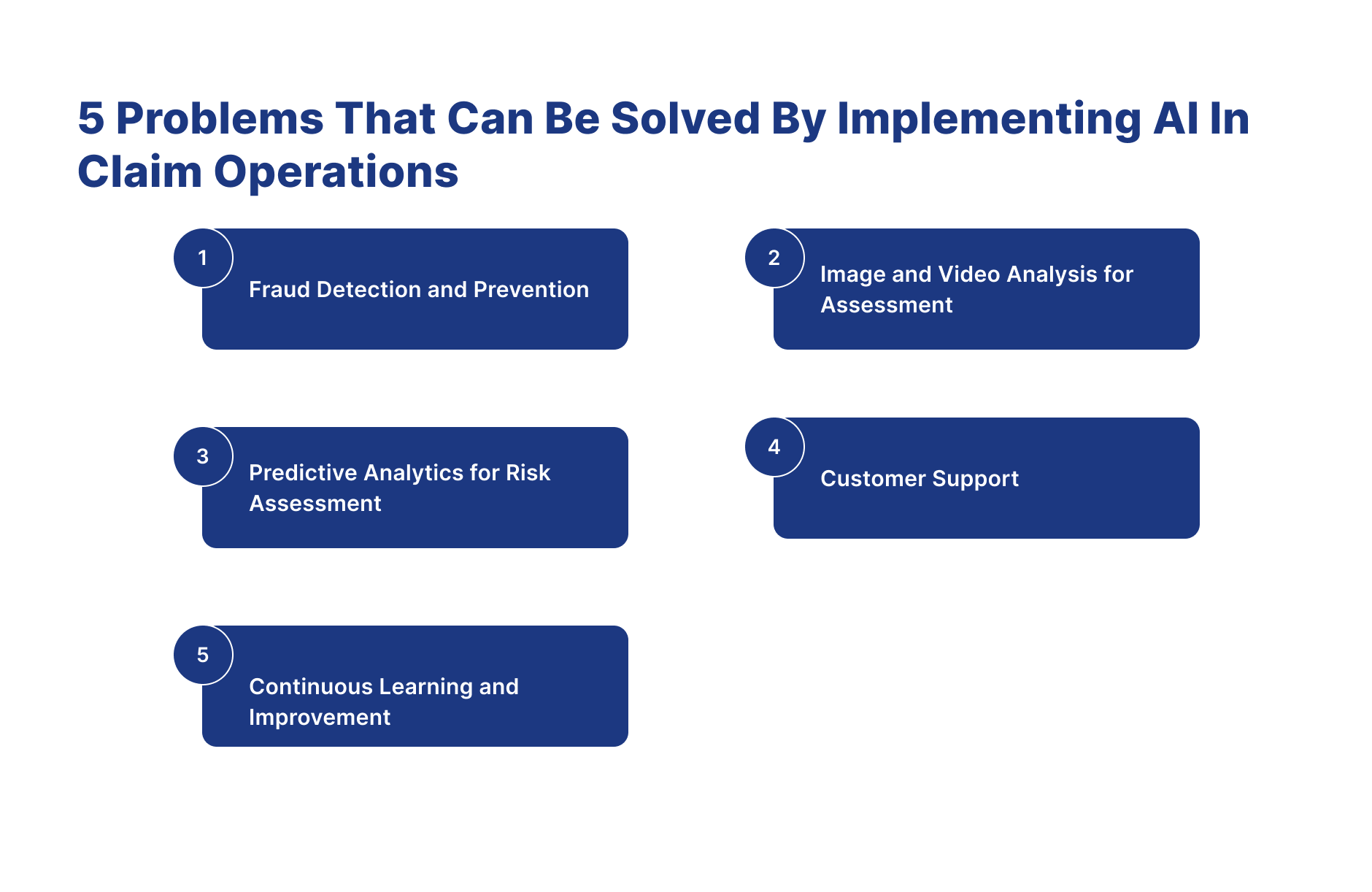5 Problems that can be solved by implementing AI in claim operations in the insurance industry
Ai in claim operations can transform claim operations, making them more efficient, accurate, and customer-centric
Introduction

- Keeping up with the times is essential in the fast-paced and ever-evolving insurance industry. One area that has considerable potential for improvement is claim operations. Manual processes and data-intensive workflows often lead to delays, errors, and increased costs. However, a game-changing solution is at hand. Utilising artificial intelligence's (AI) capabilities, insurance companies can transform claim operations, making them more efficient, accurate, and customer-centric. In this blog, we will explore captivating ways to implement AI that solve the complex challenges faced in claim operations, propelling the industry into a new era of excellence and innovation. in this blog we will examine that which type of problems that can be solve by implementing AI in claim operations.
What Problems Can AI Solve in Insurance Claim Operations?
- AI can solve major problems in insurance claim operations, such as manual data entry, fraud detection, delayed settlements, inconsistent decision-making, and poor customer communication. By automating repetitive tasks, analyzing claims data in real time, and ensuring accuracy, AI helps insurers speed up processing, reduce costs, and improve transparency.

1.Fraud Detection and Prevention
-
In the pre-AI era, insurance companies used human power to detect fraud. Insurance companies use historical data to identify the fraud. Fraudsters always use new technologies and ways to commit fraud, and because of these new ways and technologies, human power is unable to detect fraud. Because of human power, there might be some delay in detecting fraud.
-
AI may be extremely helpful in detecting fraud since it can analyze vast datasets and find patterns that point to fraudulent activity. Through continual learning from past data, machine learning algorithms enable insurers to proactively avoid and identify fraudulent claims and respond to emerging fraud patterns. this way we can solve fraud detection and prevention problem by implementing ai in claim operations.
2.Image and Video Analysis for Assessment
- In the pre-AI-era for damage assessment, the customer needs first to file a claim with the insurance company; after that, the employee will assess the damaged part, and on the basis of that assessment, he will decide whether to approve the claim or not. Sometimes, it will take time to assess the damaged part because this customer will not get the claim on time.

- The review process may be streamlined with AI-powered picture and video analysis that uses sophisticated Computer Vision algorithms. With these technologies, damages may be assessed more precisely, eliminating the need for labor-intensive physical inspections and speeding up the claims settlement process in general. this way insurance companies can solve image and video analysis for assessment by implementing AI in claim operations.
3.Predictive Analytics for Risk Assessment
-
In the pre-AI era, risk assessment was based on historical data. Insurance companies will use historical data to identify the type of risk in the insurance policy. Because of the use of historical data, insurance companies can not predict the risk which is involved in the insurance policy.
-
Predictive analytics powered by AI is excellent at seeing connections, deciphering complex patterns, and drawing insightful conclusions from various dynamic data sources. AI continuously learns and develops, keeping abreast of the constantly shifting risk landscape, in contrast to previous models, which frequently find it challenging to adjust to new threats. This improves risk assessments' accuracy while giving insurers a proactive tool to spot possible hazards before they materialize. this way insurance companies can predict risk in advance by implementing ai in claim operations.
4.Customer Support
-
In the pre-AI era, insurance companies used human power to solve customers' queries related to insurance policy claims. When companies hire new employees, they will need to train them and provide information about the claim operation. This traditional customer service process is very time-consuming and costly and insurance companies can not offer it to 24\7.
-
Chatbots driven by AI and capable of natural language processing can handle routine inquiries and provide quick and precise answers. This enhances customer service's effectiveness but alsopermits human agents to concentrate on more intricate and nuanced customer interactions. this way insurances company can improve their customer services by implementing AI in claim operations.
5.Continuous Learning and Improvement
-
Initiatives for continuous improvement were usually tricky to take off because of inflexible organizational structures and opposition to change. Traditional systems found it challenging to integrate fresh data insights or modify their strategy in response to changing industry dynamics because static algorithms and predetermined rules constrained them. This inability to adapt led to lost chances for increased productivity, improved client interactions, and improved risk control.
-
Over time, insurers can use this capacity to enhance and optimise claim procedures. AI systems become increasingly effective and efficient over time by improving their algorithms in response to fresh information and user feedback, which helps insurers keep ahead of changing market issues. this way insurance companies implement AI in claim operations to learn new things and implement it.
Conclusion
- In conclusion, AI in claim operations is not just a vision for the future; it is a realistic way to deal with the issues the sector is already facing. AI technologies provide a comprehensive solution to the intricate problems associated with insurance claim operations, ranging from automating claims processing to detecting fraud, increasing risk assessment, and enhancing customer assistance. In addition to overcoming present difficulties, insurers may set themselves up for a more effective and customer-focused future by adopting these innovations.
How Insurnest will help you to implement AI in your insurance company
-
At Insurnest, we are dedicated to assisting companies in automating critical processes. Our highly skilled and professional team ensures the timely development and delivery of AI software. We commence by thoroughly understanding our client's specific requirements, and based on these requirements, our proficient team develops the AI software. Furthermore, we provide our clients with monthly updates on the software development progress.
-
Insurnest's commitment to automation, client-centric software development, and regular updates ensures efficiency and effectiveness in streamlining insurance operations.
Contact Us
Frequently Asked Questions
How does AI automate insurance claims operations?
AI automates claims through intelligent document processing, damage assessment using computer vision, fraud detection algorithms, automated decision-making for routine claims, and predictive analytics for claim outcomes.
What benefits does AI bring to claims processing efficiency?
AI brings faster claim resolution, reduced manual processing time, improved accuracy in damage assessment, consistent decision-making, lower operational costs, and enhanced customer satisfaction through quicker payouts.
How does AI detect fraudulent insurance claims?
AI detects fraud through pattern recognition, anomaly detection, network analysis of related claims, behavioral analytics, and machine learning models trained on historical fraud data to identify suspicious activities.
What role does computer vision play in AI-powered claims processing?
Computer vision analyzes photos and videos of damage, estimates repair costs, validates claim authenticity, identifies pre-existing damage, and provides consistent damage assessment without requiring physical inspections.

